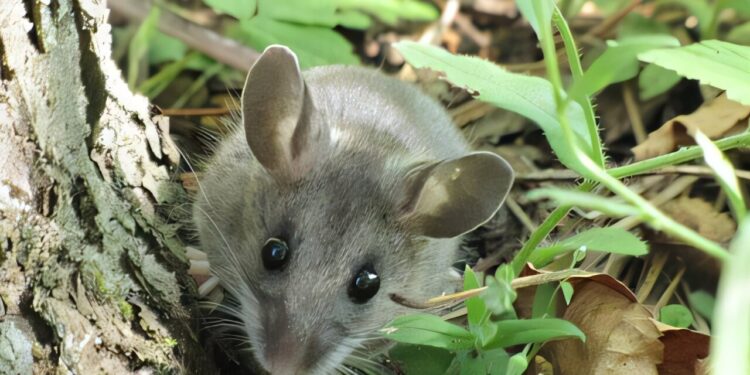The most common carrier in Hantavirus in North America is deer mouse. Credit: David M. GASCOIGNE.
Hantavirus recently made the headlines as the cause of the death of Betsy Arakawa, the wife of actor Gene Hackman, but we know little about him that his connection with rodents.
Virginia Tech researchers understood this insidious virus better by studying its rodent hosts in North America. Using the data of the National Science Foundation, they found three hot spots in the circulation of the Hantavirus in fauna – Virginia, Colorado and Texas – and identified 15 species of rodents as carriers, including six species which had not been identified previously as guests of the virus.
The details of their study were published in Ecosphere.
“This project is appropriate because the Hantavirus is considered an emerging disease of the pandemic potential with symptoms that resemble serious infections in COVID-19,” said Paanwaris Paansri, a doctorate. Student in the Department of Fish Conservation and Wildlife and Co-Author of the Study.
Hantavirus are a family of viruses that have been identified in regions around the world and can achieve mortality rates similar to other high concerns diseases, such as Nipah and Ebola. In Asia, hemorrhagic fever with renal syndrome is caused by the Hantaan virus, in Europe, this syndrome is caused by the Dobrava-Belgrade virus, and in North and South America, Hantavirus pulmonary syndrome is caused by sin and virus and viruses and hantavirus. The SIN Number virus was discovered for the first time in New Mexico in 1993.
Little is known about the ecology of hantavirus in fauna, except that the pathogenic agent is distributed to man by inhalation of excreta aerosolized, urine or saliva of asymptomatic rodent hosts, and it can be fatal in humans.
The Virginia Tech team used data from the National Ecological Network program of the National Science Foundation Observatory to acquire a better understanding of the circulation of Hantavirus in its sylvatic cycle – the life cycle of pathogen in fauna – by examining the environmental influences and the geographic distribution of rodent hosts. The program collected and tested 14,004 blood samples from 49 species in 45 field sites across the United States from 2014 to 2019.
Distribution of field sites of the National Ecology Observatory Network (neon), blood samples and seroprevalence. The figure illustrates the geographical distribution of neon field sites across the United States (blackheads) and sites with Hantavirus (yellow squares) samples. The data are aggregated by state to represent the number of blood samples (indicated by the size of the circle) and seroprevalence (represented by color scale). The number of blood samples is defined for three groups: (a) all the rodent species, (b) peromyscus maniculaus, and (c) peromyscus leukopus. Sites without HIV -positive samples (seroprevalence = 0) are represented as transparent circles. Credit: Ecosphere (2025). DOI: 10.1002 / ECS2.70209
“In North America, Peromyscus Maniculaus, deer mouse, is the most common carrier, but our study also revealed that other rodent species have a higher prevalence of Hantavirus, which changes the current paradigm in the circulation of Hantavirus in fauna,” said Paansri, whose professor of mentor FRALIN.
“This new information should help us understand where and when the Hantavirus is most likely to happen, which is crucial to predict epidemics and inform public health officials.”
The discovery of six new species of Hantavirus host rodents is important. Some of these newly discovered hosts live in regions where traditional hosts, such as deer mouse or white foot mouse (peromyscus leukopus), are absent, which means that they could be potential reservoirs of the virus in new or neglected areas.
“This widens our understanding of the basic biology of the virus and shows that the virus is more adaptable than we thought before,” said Paansri. “This has direct implications for surveillance strategies and risk assessments and can help explain certain cases of hantavirus in humans where the main reservoir is absent or rare.”
In addition to extending known host species, researchers were able to better understand seasonal trends and the effects of seasonal weather changes. For example, warmer winters and an increase in precipitation can increase rodent populations and drier conditions can facilitate the generation of contaminated dust containing particles from rodent and saliva, increasing the risk of human transmission.
“Climate change can cause population increases or rodent distribution changes, modifying the epidemiology of the Hantavirus,” said Paansri. “These fluctuations can lead to more frequent interactions of humans and increase the risk of benefits. We have found evidence that the demography of rodents and the prevalence of the Hantavirus can be planned for months in advance.”
The actual number of human cases of infections in Hantavirus is largely unknown, according to Paansri, because many infections remain silent, which means that the infected individual may not develop symptoms or that symptoms could reflect other diseases, such as colds or common flu.
Researchers plan to further explore the extent to which climatic variations influence the transmission of hantavirus into fauna and in humans.
“We believe that many lessons learned from this study can be generalized to other fauna diseases, considering that their distribution is global,” said Paansri.
More information:
Francisca Astorga et al, Hantavirus in rodents in the United States: temporal and space trends and report of new hosts, Ecosphere (2025). DOI: 10.1002 / ECS2.70209
Supplied by Virginia Tech
Quote: HOTAVIRUS revealed hotspots: Six species of new rodents identified as carriers (2025, April 10) recovered on April 11, 2025 from
This document is subject to copyright. In addition to any fair program for private or research purposes, no part can be reproduced without written authorization. The content is provided only for information purposes.



